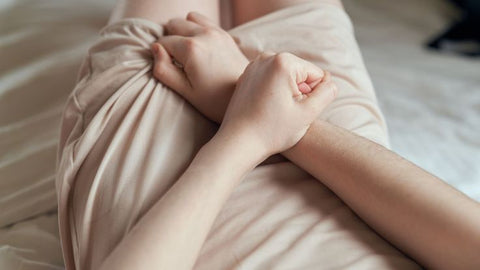Female urinary incontinence is the loss of bladder control or leakage of urine in women.
Your kidneys make urine, which is stored in your bladder, which has muscles that contract when you need to urinate. When the bladder muscle contracts, urine flows out through a tube called the urethra. At the same time, the sphincter muscle around the urethra relaxes, causing urine to flow out of your body.
Incontinence happens when your bladder muscles tighten and your sphincter muscles aren't strong enough to close off your urethra. This causes a sudden, urgent need to urinate that you may not be able to control. The pressure you put on when you laugh, sneeze, or exercise can cause urine to leak . Urinary incontinence can also occur if there is a problem with the nerves that control the muscles of your bladder and urethra.
Why do women suffer from urinary incontinence?
Men and women of a certain age are prone to suffer from these discomforts caused by the deterioration of tissues, although it is true that, due to the morphology of the female body, this disorder has a higher incidence in women. In this case, female incontinence affects 1 in 3 women over 50 years of age, the main cause of urinary incontinence in women being the weakening of the pelvic floor muscles . 40% of adult women suffer from this problem and 30% of them do not go to the specialist because they think it is a normal problem due to age or after childbirth, others feel embarrassed and others believe that there is no solution. It is a symptom undervalued by patients and underdiagnosed by professionals and overall undertreated.

According to data from the Spanish Urology Association, https://www.aeu.es/, in Spain three million women suffer from urinary incontinence.
Types of incontinence
There are 5 main types of persistent urinary incontinence:
Stress incontinence due to defective closure of the sphincter, when leaks occur when laughing, coughing, sneezing or exercising, among other circumstances.
Urge incontinence , when the need to go to the bathroom is so intense that you cannot get there in time
Mixed urinary incontinence , a combination of the two above
Overflow incontinence , a consequence of urinary obstruction, and that derived from a fistula, an orifice in the bladder-vagina communication
-
Incontinence resulting from a fistula , which is a communication hole between the bladder and the vagina, usually as a result of surgery or instrumental delivery
Functional incontinence , due to not being able to get to the bathroom in time due to a physical or mental impediment, such as severe osteoarthritis.
What causes female urinary incontinence?
Bladder control problems could be caused by:
Weakness of the muscles in the lower part of the urinary tract.
Problems or damage to the urinary tract or the nerves that control urination.
Stress incontinence can be caused by childbirth, weight gain, or other conditions that stretch the pelvic floor muscles . When these muscles can't support the bladder properly, the bladder drops and puts pressure on the vagina. A woman can't contract the muscles that close the urethra. Involuntary urine loss may occur because of the extra pressure on the bladder when she coughs, sneezes, laughs, exercises, or does other activities.
Urge incontinence is caused by an overactive bladder muscle that pushes urine out of the bladder. It can be due to bladder irritation, emotional stress, or brain conditions such as Parkinson's disease or a stroke. Many times, doctors don't know what the cause is.

Symptoms
The symptoms are often imperceptible, but other times they are very noticeable and even bothersome, which is an alarm signal to go to the doctor immediately.
The most common are:
Urine appears when you cough, sneeze, or exert yourself physically
You feel like urinating at any moment.
You can't hold your urine for long.
When you go to the bathroom you have the sensation of urinating, even if you have finished
You feel a drip when you finish urinating
You urinate while you sleep
Urine leakage during sex or orgasm
Urinary incontinence can completely affect your lifestyle, interfering with your daily activities and your social life with friends, family, etc.
Treatments
The treatment of female urinary incontinence depends on the type of incontinence suffered, as well as the age, general health conditions and the impact of this disorder on the patient's quality of life.
In the case of stress urinary incontinence - the most common in women - the main objective is to improve the quality of life of the affected person, applying different measures that help increase the resistance of the urethra. This can be achieved in different ways:
Pelvic floor muscle rehabilitation : the patient should regularly perform pelvic floor muscle contraction exercises, adapted to her age and personal characteristics. For example, Kegel exercises – which help strengthen the muscles surrounding the urethra – can help, preferably supervised by health professionals to ensure they are performed correctly.
A vaginal cone can also be used, which should be compressed with the pelvic floor muscles, although it sometimes causes discomfort and side effects that make it not a suitable device for use by all women.
Medications : In the case of stress urinary incontinence, the available drugs are not usually prescribed because they give poor results and cause side effects.
Surgery : There are various surgical techniques and, when these fail, it may be necessary in some cases to place an artificial sphincter. In some people with pelvic organ prolapse, a joint correction of the entire area is necessary, which may require the intervention of a multidisciplinary team of specialists (gynecologists, urologists, etc.).

Recommendations to improve urine loss
Incontinence symptoms can be minimized or corrected with these guidelines:
Maintain a balanced diet . It is important to follow a balanced diet, taking into account that it has been shown that being overweight is an independent risk factor for this urinary problem.
Avoid foods and drinks that irritate the bladder . It is advisable not to drink liquids that contain gas, caffeine or theine, and you should also avoid eating chocolate or spicy foods.
Pay attention to the consumption of diuretic foods , which cause increased urine production. For example, watermelon, melon, salads, asparagus or alcohol cause this diuretic effect.
Retraining the bladder and other habits . There are bladder exercises that help you learn good habits, as well as train the bladder area. In addition, it is important to avoid bad behaviors related to urination.
Strengthen the pelvic floor . Kegel exercises for the pelvic muscles can improve urinary incontinence by up to 60%.

Quit smoking . It reduces chronic coughing, so episodes of urinary incontinence will be less frequent since there is less impact on the pelvic floor muscles. In addition, tobacco acts as a bladder stimulant, so it will also improve symptoms of urinary urgency.
Controlling physical exertion . It is important to do physical exercise every day. However, women with stress urinary incontinence or significant muscle weakness should avoid physical exertion that poses a risk to the pelvic floor muscles. In this regard, exercises such as walking, swimming and all those that help to acquire good physical fitness without causing abdominal pressure are recommended.
Urinary incontinence is very common and, although it may be embarrassing to talk about it, it is important to consult with a gynecology specialist, since a high percentage find a great improvement in their quality of life.
https://www.clinicbarcelona.org/asistencia/enfermedades/incontinencia-urinaria/tratamiento
https://www.cigna.com/es-us/knowledge-center/hw/temas-de-salud/incontinencia-urinaria-en-las-mujeres-hw220313
https://espanol.womenshealth.gov/az-topics/urinary-incontinence
https://urologosquiron.com/incontinencia-urinaria-femenina/
https://www.tucanaldesalud.es/es/voz-especialista/8-medidas-tratar-incontinencia-urinaria
https://cinfasalud.cinfa.com/p/incontinencia-urinaria/




Comments (0)
There are no comments for this article. Be the first one to leave a message!